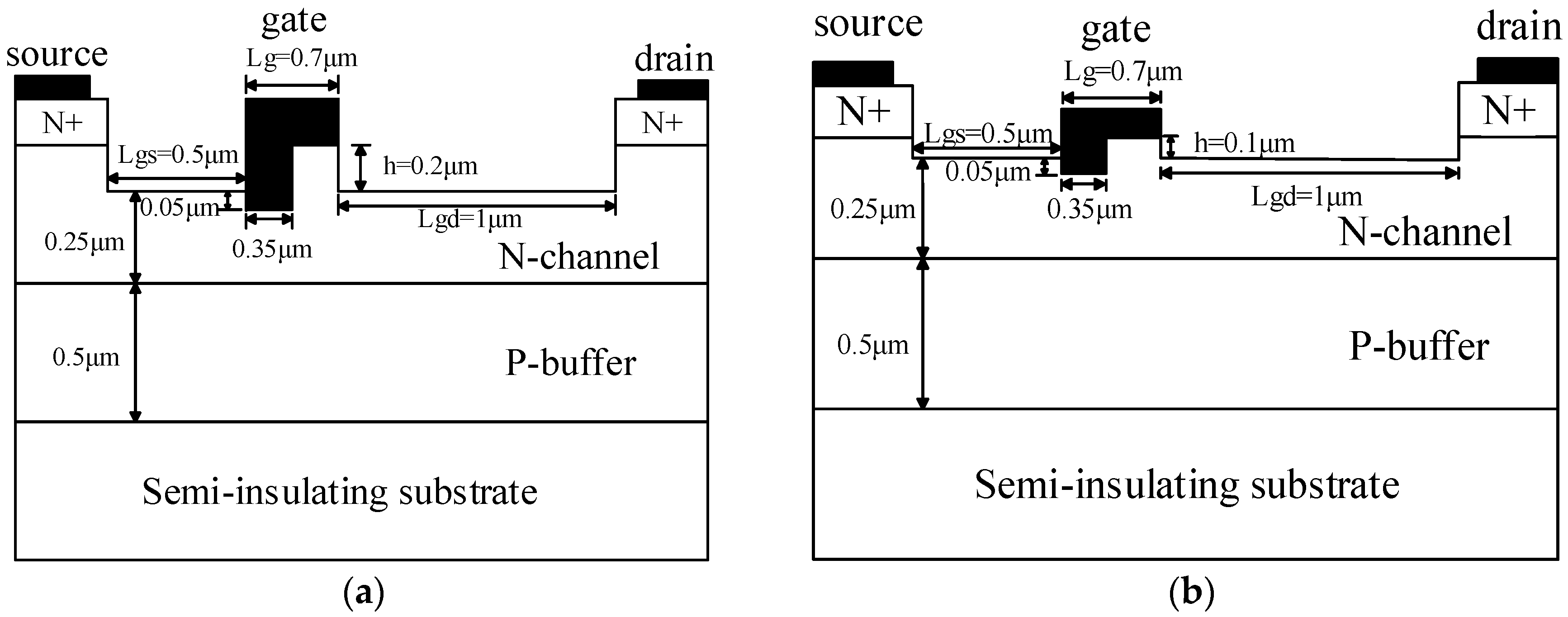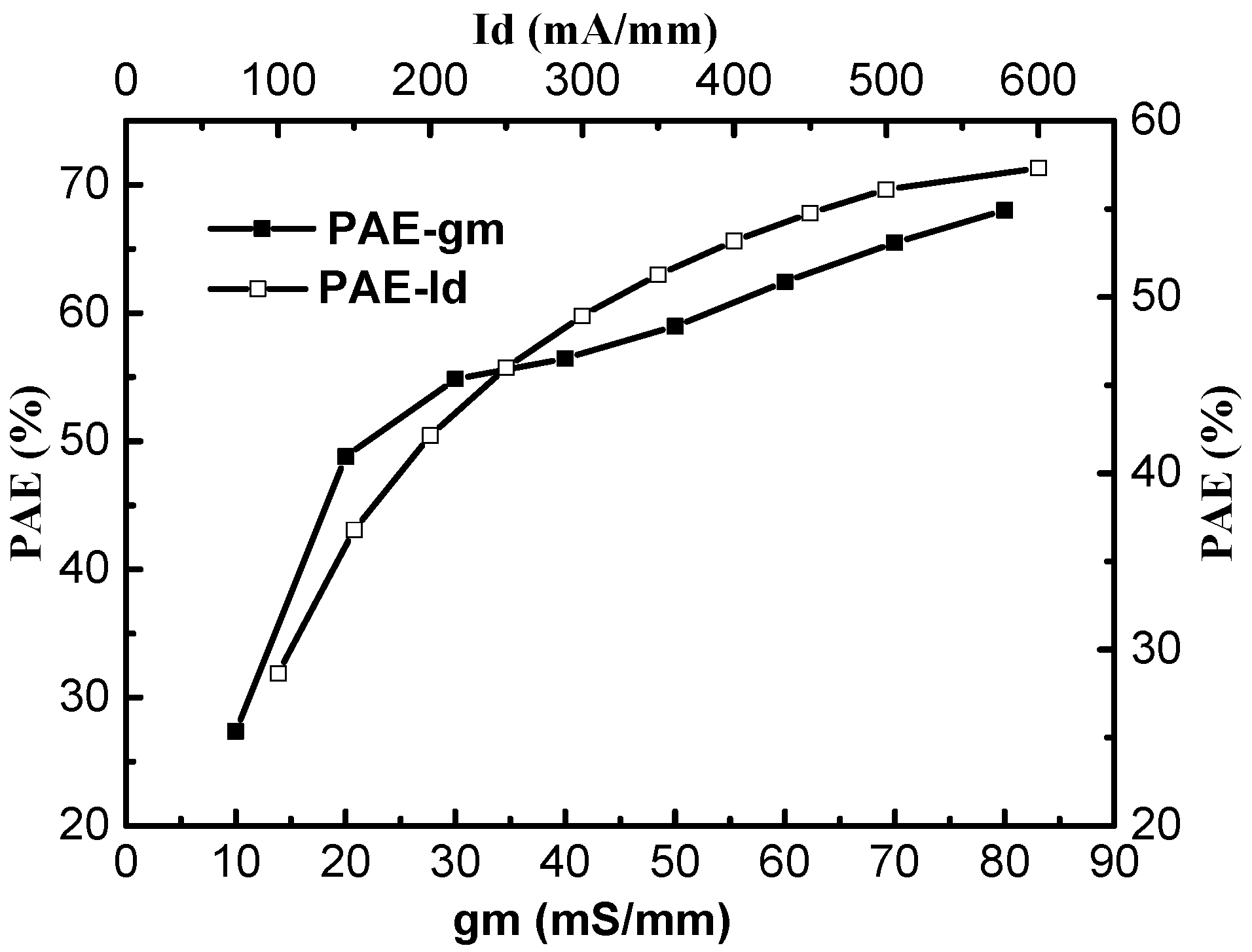An Improved UU-MESFET with High Power Added Efficiency
Abstract
:1. Introduction
2. Device Structure
3. Results and Discussion
3.1. The Influence of Structural Parameters on Power Added Efficiency (PAE)
3.2. Optimization and Analysis of the Device Structure
3.3. Discussion of the Device Structure
4. Conclusions
Author Contributions
Funding
Conflicts of Interest
References
- Cha, H.Y.; Thomas, C.I.; Koley, G.; Eastman, L.F.; Spencer, M.G. Reduced trapping effects and improved electrical performance in buried-gate 4H-SiC MESFETs. IEEE Trans. Electron Devices 2003, 50, 1569–1574. [Google Scholar]
- Zhu, C.L.; Rusli; Tin, C.C.; Zhang, G.H.; Yoon, S.F.; Ahn, J. Improved performance of SiC MESFETs using double-recessed structure. Microelectron. Eng. 2006, 83, 92–95. [Google Scholar] [CrossRef]
- Andersson, K.; Sudow, M.; Nilsson, P.A.; Sveinbjornsson, E.; Hjelmgren, H.; Nilsson, J.; Stahl, J.; Zirath, H.; Rorsman, N. Fabrication and characterization of field-plated buried-gate SiC MESFETs. IEEE Electron Device Lett. 2006, 27, 573–575. [Google Scholar] [CrossRef]
- Jia, H.J.; Yang, Z.H.; Wu, Q.Y.; Ma, P.M. Improved double-recessed P-buffer 4H-SiC MESFETs with partial heavy doped channel. Mater. Sci. Semicond. Process. 2016, 56, 213–216. [Google Scholar] [CrossRef]
- Zhang, J.P.; Luo, X.R.; Li, Z.J.; Zhang, B. Improved double-recessed 4H-SiC MESFETs structure with recessed source/drain drift region. Microelectron. Eng. 2007, 84, 2888–2891. [Google Scholar] [CrossRef]
- Jia, H.J.; Zhang, H.; Yang, Y.T. A novel 4H-SiC MESFET with a L-gate and a partial p-type spacer. Mater. Sci. Semicond. Process. 2012, 15, 2–5. [Google Scholar] [CrossRef]
- Available online: http://www.xinhuanet.com/politics/2016lh/2016-03/17/c_1118366322.htm (accessed on 5 November 2018).
- Available online: http://www.shcpo.com.cn/index.php/law/gjbwwj/245-2016-2020 (accessed on 5 November 2018).
- Jia, H.J.; Zhang, H.; Xing, D.; Luo, Y.H.; Duan, B.X. A novel 4H-SiC MESFET with ultrahigh upper gate. Superlattices Microstruct. 2015, 86, 372–378. [Google Scholar] [CrossRef]
- Cho, K.J.; Kim, J.H.; Stapleton, S.P. RF high power Doherty amplifier for improving the efficiency of a Feedforward linear amplifier. In Proceedings of the 2004 IEEE MTT-S International Microwave Symposium Digest, Fort Worth, TX, USA, 6–11 June 2004. [Google Scholar]




| Parameter | UU-MESFET | IUU-MESFET |
|---|---|---|
| Vt (V) | −9.82 | −9.17 |
| gm (mS/mm) | 55.93 | 57.84 |
| Vb (V) | 156 | 143 |
| Id (mA/mm) | 549.28 | 530.20 |
| PAE (%) | 60.16 | 70.99 |
© 2018 by the authors. Licensee MDPI, Basel, Switzerland. This article is an open access article distributed under the terms and conditions of the Creative Commons Attribution (CC BY) license (http://creativecommons.org/licenses/by/4.0/).
Share and Cite
Jia, H.; Hu, M.; Zhu, S. An Improved UU-MESFET with High Power Added Efficiency. Micromachines 2018, 9, 573. https://doi.org/10.3390/mi9110573
Jia H, Hu M, Zhu S. An Improved UU-MESFET with High Power Added Efficiency. Micromachines. 2018; 9(11):573. https://doi.org/10.3390/mi9110573
Chicago/Turabian StyleJia, Hujun, Mei Hu, and Shunwei Zhu. 2018. "An Improved UU-MESFET with High Power Added Efficiency" Micromachines 9, no. 11: 573. https://doi.org/10.3390/mi9110573
APA StyleJia, H., Hu, M., & Zhu, S. (2018). An Improved UU-MESFET with High Power Added Efficiency. Micromachines, 9(11), 573. https://doi.org/10.3390/mi9110573





